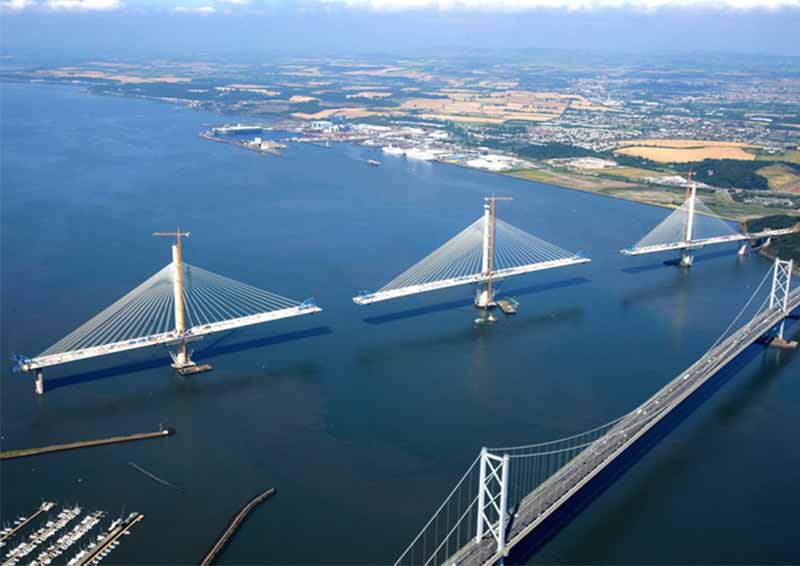Structural Health Monitoring SHM
Contents |
[edit] Introduction
Structural health monitoring (SHM - sometimes referred to as structural health and environmental monitoring) is an emerging technology used to document the viability and integrity of engineering projects such as bridges.
Christopher Beckett, lecturer in geotechnical engineering, University of Edinburgh, recognises the potential of SHM and sees it as "a burgeoning discipline" that could be "a possible solution to maintaining safety" using technology.
Beckett explains how sensors placed throughout a structure can be used to "monitor the condition of embedded reinforcement, accelerations within the structure (e.g. under wind loads) and the formation and propagation of cracks, amongst many other indicators of damage. Timely intervention, targeting the worst-affected areas, may provide the Holy Grail of a cost effective, safe solution for construction without needing to abandon coastal areas."
[edit] Types of SHM
SHM is non-evasive. Information that has been gathered through SHM can be used for maintenance purposes, but it is primarily used to detect systems that may have been compromised.
Passive SHM relies on inference or interpretation of operational data to provide the evaluation of the structural health of the project.
Active SHM attempts to detect the actual presence and extent of structural damage rather than extrapolate the condition based on interpretation.
[edit] Expanding role of SHM
SHM can now be used to record changes - or the absence of changes - in the characteristics of materials and structures. It can also be used to estimate the degradation of infrastructure, either due to age or extreme events such as floods, earthquakes, explosions and so on.
SHM systems can include wired or wireless sensors (over wired or wireless sensor networks) that are embedded into structures. These sensors record all types of movement so that it can be analysed.
[edit] SHM and bridges
When applied to bridges, SHM can produce valuable data sets that can aid key decisions about current performance, margins of safety, actual loading, stress history, extent of deterioration and residual life.
Long span bridges in particular can benefit from the sensing technology that is incorporated into SHM. The Queensferry Crossing (originally known as the Forth Replacement Crossing) across the Firth of Forth is one of the largest infrastructure projects of its kind. The 2.7 km structure is the longest three-tower, cable-stayed bridge in the world, as well as by far the largest to feature cables which cross mid-span. It was constructed with thousands of sensors as part of its SHM monitoring system. Since it opened in 2017, SHM professionals have been able to use a web-based system to access the data that has been collected by the sensors.
[edit] Related articles on Designing Buildings Wiki
Featured articles and news
RTPI leader to become new CIOB Chief Executive Officer
Dr Victoria Hills MRTPI, FICE to take over after Caroline Gumble’s departure.
Social and affordable housing, a long term plan for delivery
The “Delivering a Decade of Renewal for Social and Affordable Housing” strategy sets out future path.
A change to adoptive architecture
Effects of global weather warming on architectural detailing, material choice and human interaction.
The proposed publicly owned and backed subsidiary of Homes England, to facilitate new homes.
How big is the problem and what can we do to mitigate the effects?
Overheating guidance and tools for building designers
A number of cool guides to help with the heat.
The UK's Modern Industrial Strategy: A 10 year plan
Previous consultation criticism, current key elements and general support with some persisting reservations.
Building Safety Regulator reforms
New roles, new staff and a new fast track service pave the way for a single construction regulator.
Architectural Technologist CPDs and Communications
CIAT CPD… and how you can do it!
Cooling centres and cool spaces
Managing extreme heat in cities by directing the public to places for heat stress relief and water sources.
Winter gardens: A brief history and warm variations
Extending the season with glass in different forms and terms.
Restoring Great Yarmouth's Winter Gardens
Transforming one of the least sustainable constructions imaginable.
Construction Skills Mission Board launch sector drive
Newly formed government and industry collaboration set strategy for recruiting an additional 100,000 construction workers a year.
New Architects Code comes into effect in September 2025
ARB Architects Code of Conduct and Practice available with ongoing consultation regarding guidance.
Welsh Skills Body (Medr) launches ambitious plan
The new skills body brings together funding and regulation of tertiary education and research for the devolved nation.
Paul Gandy FCIOB announced as next CIOB President
Former Tilbury Douglas CEO takes helm.
UK Infrastructure: A 10 Year Strategy. In brief with reactions
With the National Infrastructure and Service Transformation Authority (NISTA).























